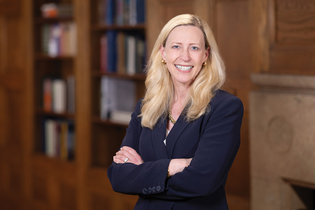
Dan Renzetti
The Yale Alumni Magazine publishes a letter from President Maurie McInnis ’96PhD in every issue. This time, the page includes excerpts from the remarks she made at her inauguration on April 6.
View full image
What follows are excerpts from remarks President McInnis made at her inauguration on April 6. Read the full address online here.
Friends and faculty, students and staff; trustees; honored guests and devoted alumni; my distinguished predecessors, Peter Salovey, Rick Levin, and—in absentia—the trailblazing Hanna Gray, it is the thrill of a lifetime to stand before you today. And I am grateful for the trust you have bestowed upon me. Leading any university is a rare gift. Leading Yale is an honor without parallel.
Twenty-three leaders before me have been given this privilege. They have served in times of peace and peril, solidarity and strife. One former Yale president, in his own inaugural address, spoke at length about what he termed the “breeze of public criticism . . . blowing freshly through the halls of ancient learning.” And mind you—this was President Noah Porter, in 1871. Today, it’s fair to say that breeze feels like a gale-force wind.
At a time when national and world events seem to roil us, when our students and postgraduate scholars face growing challenges, including a crisis of division and loneliness, and our faculty and staff face daunting external pressures, we are left with a simple, inescapable question: How do we do this work? Not only the work of a university president, but the work we all do at Yale, to nurture, and steward, and propel this cherished institution into the future. The answer for me came from my background as a scholar of art and architecture.
I found it in two buildings that could not be more different from one another. The first—a humble vernacular schoolhouse in Frostproof, Florida. The second—a soaring Gothic cathedral in Paris, France.
When Claudia and Christopher Hobbs settled down in central Florida, Frostproof was only one generation removed from being an uninhabited swampland. The wood-frame schoolhouse they opened in 1905 was the town’s first public building.
A humble addition—but one that transformed the village from a wilderness that cultivated briars and fruit to a community that cultivated minds.
Inside that little schoolhouse, Claudia and Christopher, my great-grandparents, delivered humanity’s defining gift—the most enduring of all—the gift of education. That gift is not a birthright belonging to the affluent or influential few. It belongs in equal measure to the children of the swamplands. The children of the heartland. The children of all those places where the ivy doesn’t grow.
Growing up in Knoxville, Tennessee—and born before Yale accepted women as undergraduates—I never considered that Yale might be a place for someone like me. But I arrived here nonetheless, 35 years ago, to pursue my PhD. I think about all those things that might have kept me distant. But what I keep coming back to is the closeness I feel with this place. At every turn, Yale has taught me that the schoolhouse belongs to all of us—and in the schoolhouse, we all belong.
Now, you’ll remember I said I found my answer in two buildings.
When Notre-Dame de Paris was built in the twelfth century it differed from its predecessors in important ways. Chief among them: It brought in more light.The cathedral we know today speaks to different eras and styles, precisely because it has survived them all. Notre-Dame evolved and endured. Not unscathed, but undefeated. Not unchanged, but unmoved. Stronger for its scars — and more sacred for all it had weathered.
Throughout our history: We have endured. Together with our home city of New Haven, we have weathered the storms of every moment. And so, I return to the question I asked of myself—the question I asked of all of us: how do we lead Yale into the future?
We do it by remembering that Yale is both the schoolhouse and the cathedral. A universal house of knowledge and a singular work of art, one that grows stronger, shines brighter, and reaches ever more dizzying heights with every challenge it overcomes.
Each time our mettle is tested, Yale answers the call. Not by yielding to the winds of change but by leading change ourselves. Not by cloistering ourselves in our cathedral but by engaging with the world as it is. Not by straying from our mission, but by strengthening it to meet every moment we face.
At the heart of our effort is our commitment to free expression—first codified 50 years ago in the landmark Woodward Report. Today, we must hold fast to that promise. Ensuring that Yale is not an ivory echo chamber, but a place where curiosity is fostered, and where people and ideas alike are free to flourish.
I look forward to the work ahead because I love Yale, both for its simplicities and its complexities. The common gift of knowledge that belongs to all of us. And the uncommon possibilities that are made possible on this hallowed ground.
Most of all, I believe firmly that Yale’s future is even brighter than our past. Because woven in the briar before us, I see extraordinary opportunities that fill me with optimism and hope. To cultivate minds. To endure and to thrive. To build something beautiful together.
Thank you for the honor of building that future alongside you.
 loading
loading